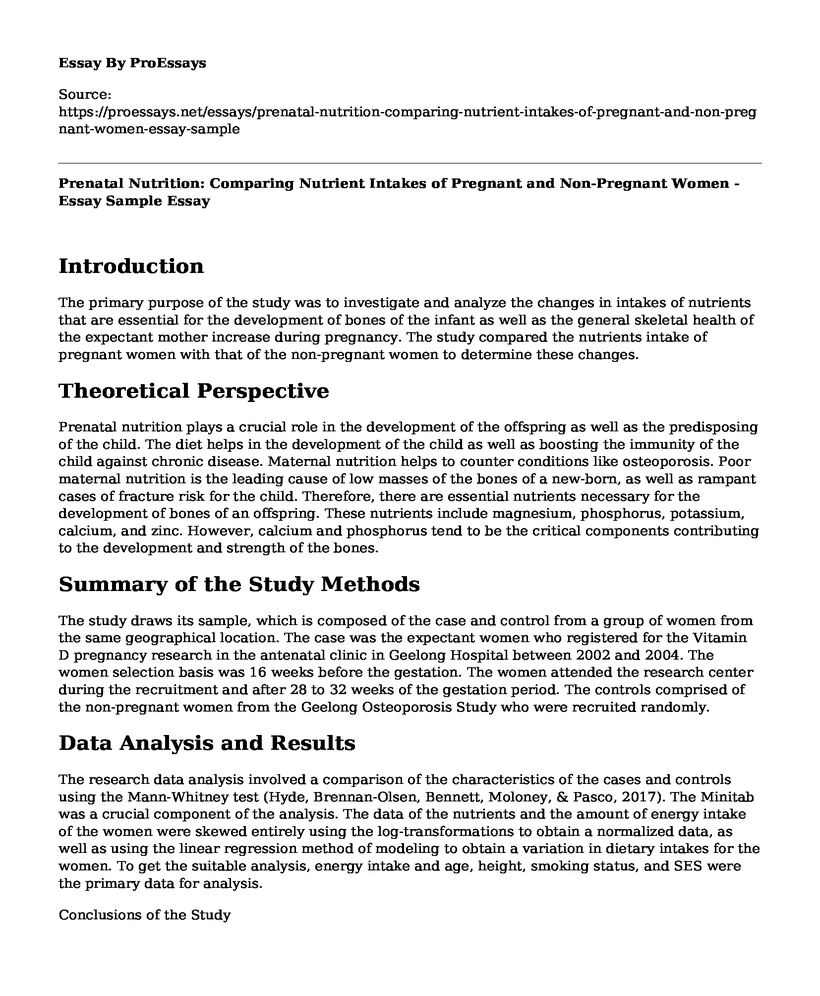Introduction
The primary purpose of the study was to investigate and analyze the changes in intakes of nutrients that are essential for the development of bones of the infant as well as the general skeletal health of the expectant mother increase during pregnancy. The study compared the nutrients intake of pregnant women with that of the non-pregnant women to determine these changes.
Theoretical Perspective
Prenatal nutrition plays a crucial role in the development of the offspring as well as the predisposing of the child. The diet helps in the development of the child as well as boosting the immunity of the child against chronic disease. Maternal nutrition helps to counter conditions like osteoporosis. Poor maternal nutrition is the leading cause of low masses of the bones of a new-born, as well as rampant cases of fracture risk for the child. Therefore, there are essential nutrients necessary for the development of bones of an offspring. These nutrients include magnesium, phosphorus, potassium, calcium, and zinc. However, calcium and phosphorus tend to be the critical components contributing to the development and strength of the bones.
Summary of the Study Methods
The study draws its sample, which is composed of the case and control from a group of women from the same geographical location. The case was the expectant women who registered for the Vitamin D pregnancy research in the antenatal clinic in Geelong Hospital between 2002 and 2004. The women selection basis was 16 weeks before the gestation. The women attended the research center during the recruitment and after 28 to 32 weeks of the gestation period. The controls comprised of the non-pregnant women from the Geelong Osteoporosis Study who were recruited randomly.
Data Analysis and Results
The research data analysis involved a comparison of the characteristics of the cases and controls using the Mann-Whitney test (Hyde, Brennan-Olsen, Bennett, Moloney, & Pasco, 2017). The Minitab was a crucial component of the analysis. The data of the nutrients and the amount of energy intake of the women were skewed entirely using the log-transformations to obtain a normalized data, as well as using the linear regression method of modeling to obtain a variation in dietary intakes for the women. To get the suitable analysis, energy intake and age, height, smoking status, and SES were the primary data for analysis.
Conclusions of the Study
The results of the data analysis indicated no significant variation in the age and height of the cases and controls. The smoking habit of the facts and controls had no significant influence on the result. The main difference, however, was in the intake of calcium, carbohydrates, fats, and potassium, where the result indicated that cases were consuming more of these nutrients in comparison to the controls. An adjustment in the multivariate revealed that there were lower intakes of protein, zinc, and magnesium for cases as compared to the controls. Thus, a large number of cases met the base requirement for potassium and calcium as compared to the authorities.
Problems With the Study
The study involved the use of a convent sample. The sample might not give a true reflection of the whole population of pregnant women. The study was mainly dealing with the diet only and did not pay any attention to supplements, which can adversely affect the outcomes. The research relied on several measurement equipments. Therefore, several errors can occur when doing measurements. The responses of the cases and the controls are subjected to bias depending on the environment of the study.
Implications of the Study
The study shows that expectant women were not using the recommended amounts of most nutrients. Their need for these nutrients was high in comparison to those of the non-pregnant women. As a result, the pregnant women were not showing possibilities of attaining the national health recommendations as compared to the non-pregnant counterparts. However, they were likely to achieve the calcium and potassium national targets.
Conclusion
The study is essential as it creates a basis for the study of the nutritional requirements of pregnant women. The study also helps to examine and breakdown the crucial nutrients for pregnant women. Besides offering vital information on the nutrients requirement for bone development, the study presents the balancing for the nutrients as well as their importance on the health of a pregnant woman.
Thoughts on Strengthening the Study
The study takes a holistic approach when sampling and collecting data from the cases and the controls. Many other factors affect the nutritional requirements of a population rather than just the geographical location. Therefore, the study should focus more on other factors like health history, economic conditions, and social aspects of the cases and controls.
References
Hyde, N. K., Brennan-Olsen, S. L., Bennett, K., Moloney, D. J., & Pasco, J. A. (2017). Maternal nutrition during pregnancy: intake of nutrients essential for bone health. Maternal and child health journal, 21(4), 845-851.
Cite this page
Prenatal Nutrition: Comparing Nutrient Intakes of Pregnant and Non-Pregnant Women - Essay Sample. (2023, Mar 03). Retrieved from https://proessays.net/essays/prenatal-nutrition-comparing-nutrient-intakes-of-pregnant-and-non-pregnant-women-essay-sample
If you are the original author of this essay and no longer wish to have it published on the ProEssays website, please click below to request its removal:
- Research Paper on Population Health Policy Analysis
- Recommendation Letter for Pharmacy Course
- Acromegaly: A Rare, Serious, Insidious, Chronic, but Treatable Disease - Essay Sample
- Essay Sample on Promotion of Language, Speech, and Communication
- Essay Example on Vaping Devices: Benefits & Risks of Nicotine-Based E-Liquids
- Essay on Estonia Protects People With Disabilities: Challenges and Opportunities
- Social Work Ethics and Values Essay Example







